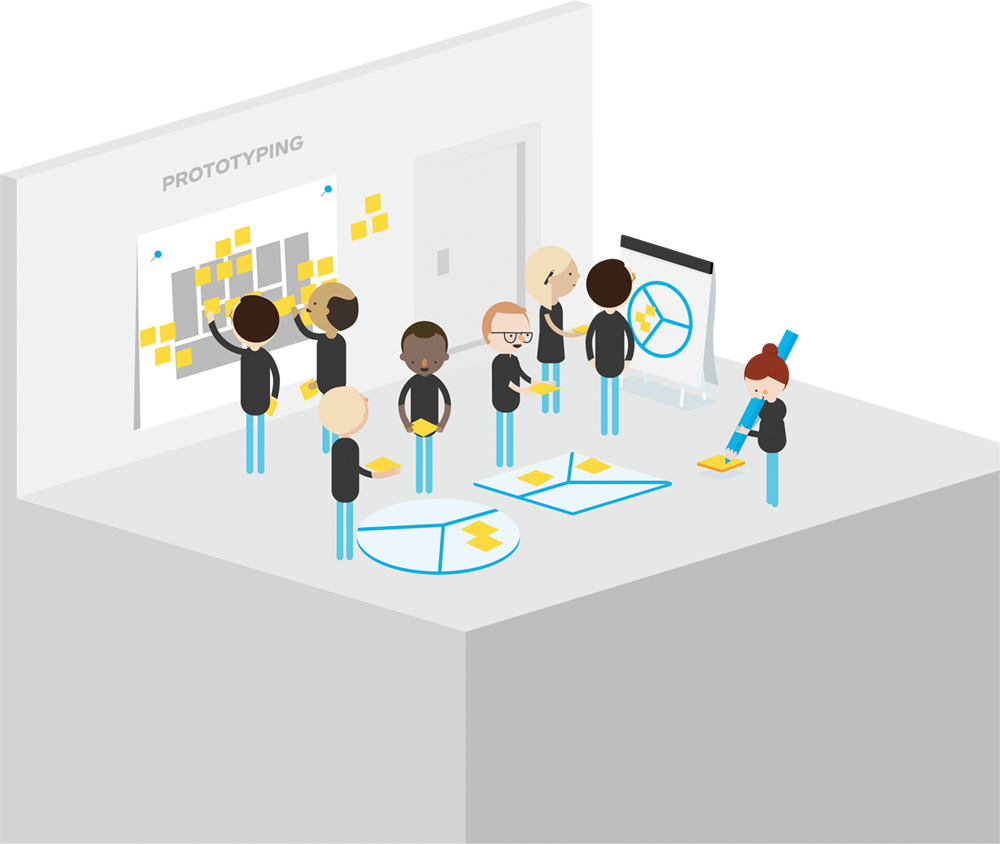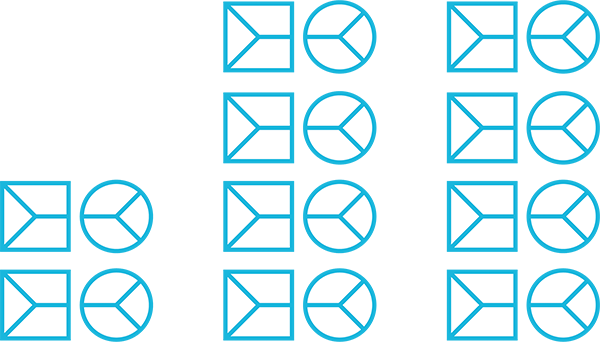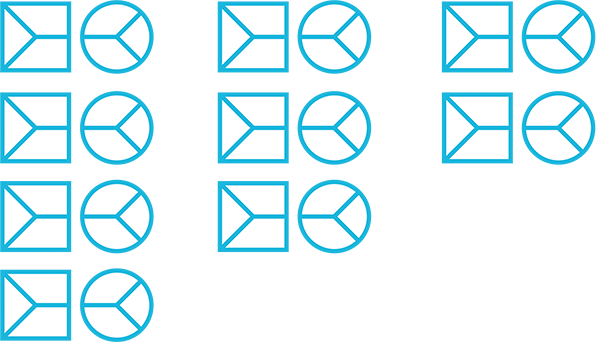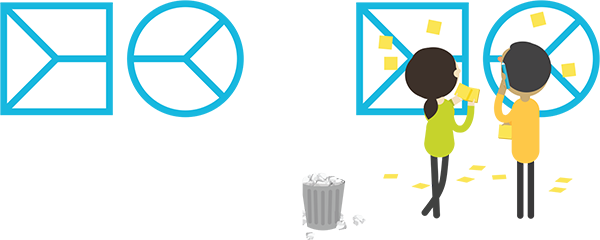Use the activity of making quick and rough study models of your idea to explore alternatives, shape your value proposition, and find the best opportunities. Prototyping is common in the design professions for physical artifacts. We apply it to the concept of value propositions to rapidly explore possibilities before testing and building real products and services.
DEF-I-NI-TION
The practice of building quick, inexpensive, and rough study models to learn about the desirability, feasibility, and viability of alternative value propositions and business models.
Make alternatives tangible with napkin sketches. Use a single sketch for every potential direction your idea could take.
Flesh out possible directions with the Value Proposition Canvas. Understand which jobs, pains, and gains each alternative is addressing.
Help customers and partners understand potential value propositions by bringing them to life without building them.
Build a minimum feature set that brings your value proposition to life and allows testing it with customers and partners.
Tips
Spend a maximum of 5 to 15 minutes on sketching out your early prototypes. Always use a visible timer and stick to a predefined time frame. Don’t discuss too long which one of several possible directions to prototype. Prototype several of them quickly and then compare. Remember constantly that prototyping is an exploratory tool. Don’t spend time on the details of a prototype that is likely to change radically anyway.
Unlock the power of prototyping. Resist the temptation of spending time and energy refining one direction only. Rather, use the principles described here to explore multiple directions with the same amount of time and energy. You will learn more and discover better value propositions.
Get “10 Prototyping Principles” poster.
1 Make it visual and tangible. These kinds of prototypes spark conversations and learning. Don’t regress into the land of blah blah blah.
2 Embrace a beginner’s mind. Prototype “what can’t be done.” Explore with a fresh mind-set. Don’t let existing knowledge get in the way of exploration.
3 Don’t fall in love with first ideas— create alternatives. Refining your idea(s) too early prevents you from creating and exploring alternatives. Don’t fall in love too quickly.
4 Feel comfortable in a “liquid state.” Early in the process the right direction is unclear. It’s a liquid state. Don’t panic and solidify things too early.
5 Start with low fidelity, iterate, and refine. Refined prototypes are hard to throw away. Keep them rough, quick, and cheap. Refine with increasing knowledge about what works and what doesn’t.
6 Expose your work early—seek criticism. Seek feedback early and often before refining. Don’t take negative feedback personally. It’s worth gold to improve your prototype.
7 Learn faster by failing early, often, and cheaply. Fear of failure holds people back from exploring. Overcome that with a culture of rough and quick prototyping that keeps failure cheap and leads to faster learning.
8 Use creativity techniques. Use creativity techniques to explore groundbreaking prototypes. Dare to break out of how things are usually done in your company or industry.
9 Create “Shrek models.” Shrek models are extreme or outrageous prototypes that you are unlikely to build. Use them to spark debate and learning.
10 Track learnings, insights, and progress. Keep track of all your alternative prototypes, learnings, and insights. You might use earlier ideas and insights later in the process.
PROCESS Make Ideas Visible with Napkin Sketches
OBJECTIVE
Quickly visualize ideas for value propositions
Outcome
Alternative prototypes in the form of napkin sketches
Napkin sketches are a rough representation of a value proposition or business model and highlight only the core idea, not how it works. They are rough enough to fit on the back of a napkin and still communicate the idea. Use them early in your prototyping process to explore and discuss alternatives.
What is a napkin sketch?
Napkin sketches are a cheap way to make your ideas more tangible and shareable. They avoid going into the details of how an idea works to steer clear of getting hung up with implementation issues.
What is it used for?
Use napkin sketches to quickly share and evaluate ideas during the early value proposition design process. Their roughness is deliberate so you can throw ideas away without regret and explore alternatives. You may also use them to gather early feedback from customers.
Caveat
Make sure people understand that napkin sketches are an exploratory tool. You will kill or transform many of the sketched out ideas during the prototyping and testing process.
The best napkin sketches…
1 Brainstorm · 15–20 min Use different brainstorming techniques, such as trigger questions, 17, 31, 33 or “what if” questions to generate a large quantity of possible directions for interesting value propositions. Don’t worry about choice at this stage. Quantity is better than quality. These are quick and dirty prototypes that will change inevitably.
2 Draw · 12–15 min Participants split into break-out groups, and each group quickly picks three ideas for three alternative value propositions. They draw a napkin sketch for each one on a flip chart. Making two or three sketches increases diversity and reduces the risk of endless discussions.
3 Pitch · 30 sec per group One team member of each break-out group takes the stage and pitches the (large) napkin sketches. Each pitch should be no longer than 30 seconds—just enough to outline what the idea is about, not to explain how it works! Make sure there is sufficient diversity across the groups or else send everybody back to the drawing board.
4 Display All napkin sketches are exposed in a sort of gallery on the wall. You should now have a nice diversity of alternative directions.
5 Dotmocracy · 10–15 min (ideally over a break) Participants get 10 stickers to vote for their favorite ideas. They can give all votes to one idea or distribute them among several napkin sketches. This is not a decision-making mechanism. It is a process that highlights the ideas that participants are most excited about.
6 Prototype Break-out groups continue by sketching out a value proposition canvas for the one napkin sketch out of their three that got most votes. Potentially redistribute the napkin sketches that got most votes among the different groups.
EXERCISE Create Possibilities Quickly with Ad-Libs
OBJECTIVE
Quickly shape potential value proposition directions
OUTCOME
Alternative prototypes in the form of “pitchable” sentences
Ad-libs are a great way to quickly shape alternative directions for your value proposition. They force you to pinpoint how exactly you are going to create value. Prototype three to five different directions by filling out the blanks in the ad-lib below.
PROCESS Flesh out Ideas with Value Proposition Canvases
OBJECTIVE
Sketch explicitly how different ideas create customer value
OUTCOME
Alternative prototypes in the form of Value Proposition Canvases
Use the Value Proposition Canvas to sketch out quick alternative prototypes, just like you would with napkin sketches or ad-libs. Don’t just work with the canvas to refine final ideas, but use it as an exploratory tool until you find the right direction.

 help(s)
help(s)  who want to
who want to  by
by  and
and  . (Tip: Add at the beginning or end of sentence: unlike
. (Tip: Add at the beginning or end of sentence: unlike  )
)![]()


 Use a visible timer to constrain the time you spend working on a specific prototype. Keep early prototypes short.
Use a visible timer to constrain the time you spend working on a specific prototype. Keep early prototypes short.


 help(s)
help(s)  who wants to
who wants to  by
by  and
and  .
.